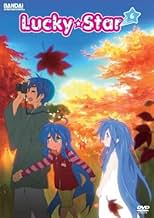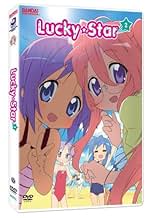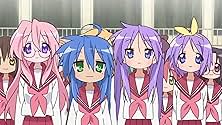Divirtiéndose en la escuela, haciendo los deberes juntos, cocinando y comiendo, jugando videojuegos, viendo anime. Todas estas pequeñas cosas conforman la vida diaria de Izumi Konata, amante... Leer todoDivirtiéndose en la escuela, haciendo los deberes juntos, cocinando y comiendo, jugando videojuegos, viendo anime. Todas estas pequeñas cosas conforman la vida diaria de Izumi Konata, amante del anime y el chocolate, y sus amigos.Divirtiéndose en la escuela, haciendo los deberes juntos, cocinando y comiendo, jugando videojuegos, viendo anime. Todas estas pequeñas cosas conforman la vida diaria de Izumi Konata, amante del anime y el chocolate, y sus amigos.
Opiniones destacadas
Story - Just like i've said earlier, there isn't any, to be honest. The plot lean heavily towards japan otaku culture as there are many reference/parody with Kyoto Animation's earlier productions. It could also be viewed negatively since some with limited amount of understanding towards otaku culture wouldn't find it funny, to say the least.
Character - The series' main highlight, is the prime otaku Konata Izumi, which is also voiced by Aya Hirano who did Suzumiya Haruhi. With a considerable amount of nonsensical knowledge about anime, doujinshi and video games. It has certainly made up quite the irony for her to have an athletic body. Along with her satirical jokes towards her friends, the character has generated quite some commotion among anime fans.
Moe is definitely sky-high with the presence of Miyuki Takara, a polite, friendly glasses-wearing girl with almost complete knowledge just about anything. That's about it on her good side. I find the majority of scenes consisting her to be absurdly boring, since she's always explaining tedious facts to the dumbfounded aka Konata.
The other 2 characters consists of Kagami Hiiragi and Tsukasa Hiiragi; a fraternal twin. The elder one which is Kagami is your stereotype tsundere, while the younger Tsukasa is often described as an airhead who always can't keep up with the conversation and frequently hinted in the series as a naive person.
Music - I believe everyone's first impression towards the opening theme is Suzumiya Haruhi's ending theme. A catchy j-pop with some eurodance elements combined with a dance scene with the main characters. Both themes has been parodied more than a thousand times by media or fans. The BGM is fairly decent, one that stood-out for me is the one being played at Episode 22. I don't wanna give away too much for those who is still behind this series.
Animation - Can't give too many compliments for this area, as the animation is as simple as it gets. The main characters are drawn quite nicely and with detail, but the backgrounds are mainly consists of black/blue figures. Though i might say that this fits the anime perfectly.
Overall - It is definitely a great comeback by Kyoto Animation after their big hit. Although it has some really tedious, dragged out conversations; Lucky Star has its moments, and some which is undeniably funny. This is one anime that doesn't rely on exaggerated sword fights and epic mecha/robot battles for a big audience. However, if you're interested in the latter, look elsewhere.
A solid 7/10.
That is it.
No grand adventure, no magical powers, nothing special, nothing complex, just plain and simple. The simplicity of the entire concept behind this production is clearly evident in the animation style. Clean lines, easy-to-draw character designs, basic color fills and plain backgrounds. Even the actual movements of the characters are un-sophisticated and the animation itself is far from what anyone would consider "dynamic". Nothing really stands out, making this series merely "a face in the crowd".
But that is exactly what the series is. It never tries to be more than what it is, never gives in to the whims and fancies of a viewer-ship that extols mainly the action and drama genre. It stays true to its own identity despite running the risk of ending up as an "outcast" of sorts among the more popular kids on the block. In a way, the very attitude that this series adopts toward other mainstream anime and its audience is personified in the main character, Konata Izumi.
Affectionately called "Kona-chan", Konata is the ultimate embodiment of one of Lucky Star's main target audience: otakus. She is everything and otaku is as well as wishes to be. A die hard anime fan, a video game addict and a slacker, Konata is quick to incorporate references to obscure anime culture in her conversation, has a habit of copying homework and doing last minute revision before exams, lines up for hours at manga conventions and works in a comic shop. However, she is also extremely athletic, miraculously aces her every test, and most importantly, she is accepted by her friends despite possessing attributes that would easily render one an unpopular social outcast. A very clever parallel to the nature of the show itself.
That being said, it is the characters, and the fresh new perspectives they give on the otherwise mundane happenings of life, that is the main attraction of the show. Through the eyes of the quirky Konata, the hot headed but innately emotional Kagami, the adorably innocent dim-bulb Tsukasa and the polite and beautiful "walking wikipedia" Miyuki, the audience is treated to different facets of every day Japanese life presented in new lights from varying points of view. For non-Japanese fans, it is a light hearted immersion into aspects of the Japanese culture without the show becoming a sort of "Discovery Travel and living" documentary. Comedy is well placed and well written, extending even into the laugh-out-loud "Lucky channel" segments at the end of each episode.
Believe it or not, it is this simplicity, this sense of "normalcy" and the presentation of the mundane everyday going-ons through new anime-styled eyes, that is the ultimate form of escapism. In a world fret with overly sexualized portrayals of the female figure, Lucky star presents a feeling of carefree innocence barring the occasional allusion to Miyuki's near perfect "curves". In a life of fluctuation, surrounded by tragedy reported in the daily news, Lucky Star's predictability and optimism is more than welcome. Things and people around us, people that we know, constantly change and sometimes for the worse. Lucky Star's characters never change from the first episode right up to the last. Some might say that is just an indication of a lack of character development, but it works to establish the identity of the core characters, in a way making them feel more "real". A closer look into the style of interaction among the characters shows how realistically each conversation plays out, augmented by some top notch voice acting.
As it stands, adapting a 4 panel comic into an anime series is no easy task. The source material itself has more in common with the newspaper comic "Peanuts" than your standard manga. Yet despite the scant amount of story details, the anime series managed to remain faithful to the spirit of the source while expanding on its core aspects. This resulted in the anime even replicating the general lack of coherent story from the manga. Each episode seems to have a running theme yet there is never a sense of focus in the episode's narrative. The second half of the series sees the introduction of more characters but none seem to be as interesting as the core four.
For being just "another face in the crowd" among other more popular anime, Lucky Star has managed to earn a dedicated fandom based on the very fact that it is something different. It embraces the culture and attitude of its main target audience, parodying it yet glamorizing it at the same time. When you watch Lucky Star, you do not just watch a show, you pay a visit to some extremely lovable characters, more human than you might imagine, and just hang out with them.
In the midst of all the funny, there is one episode (Ep. 22) that is more heartfelt and brought tears to my eyes. And I always give bonus points to shows that can make me laugh and cry at the same time, so I really appreciate that about this anime!
All things considered, this anime is approaching 13 years old now which is unbelievable. The sad moments in all of Kyoto Animations work are all the more sad since July 18 2019, when the arson attack happened. The final death toll was 36, and I'm still very upset by it even after 7 months. If there's any silver lining, it's caused me to appreciate this anime studio's work more and more lately, so hence why I began watching more of KyoAni's works. I will continue to support them until the day I die!!!
Definitely give Lucky Star a watch if you like the moe/slice-of-life genre!
¿Sabías que…?
- TriviaDirector Yutaka Yamamoto was fired after directing only four episodes.
- Citas
Tsukasa Hiiragi: You know how the chicken's the parent and the egg's the child? And how mayonnaise is made from eggs, too? I call that the Relative Bowl.
- Versiones alternativasThe English dubbed version of this series only changes the dialogue to English; all of the songs heard throughout the series are still in the original Japanese.
- ConexionesFeatured in WatchMojo: Top 10 Slice of Life Anime (2018)
- Bandas sonorasMotteke! Sêrâ Fuku
(Take It! Sailor Uniform)
Opening Theme
Performed by Aya Hirano, Emiri Kato, Kaori Fukuhara, and Aya Endô
Selecciones populares
- How many seasons does Lucky Star have?Con tecnología de Alexa
Detalles
- Tiempo de ejecución25 minutos
- Color
- Mezcla de sonido
- Relación de aspecto
- 1.78 : 1






























